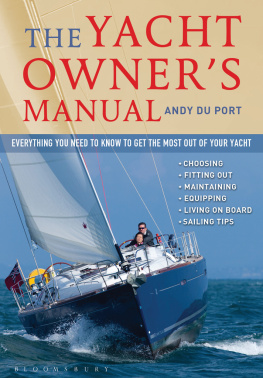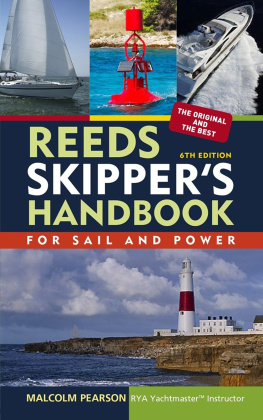Du Port Andy - Reeds VHF Handbook
Here you can read online Du Port Andy - Reeds VHF Handbook full text of the book (entire story) in english for free. Download pdf and epub, get meaning, cover and reviews about this ebook. year: 2021, publisher: Bloomsbury Publishing Plc, genre: Children. Description of the work, (preface) as well as reviews are available. Best literature library LitArk.com created for fans of good reading and offers a wide selection of genres:
Romance novel
Science fiction
Adventure
Detective
Science
History
Home and family
Prose
Art
Politics
Computer
Non-fiction
Religion
Business
Children
Humor
Choose a favorite category and find really read worthwhile books. Enjoy immersion in the world of imagination, feel the emotions of the characters or learn something new for yourself, make an fascinating discovery.
- Book:Reeds VHF Handbook
- Author:
- Publisher:Bloomsbury Publishing Plc
- Genre:
- Year:2021
- Rating:4 / 5
- Favourites:Add to favourites
- Your mark:
- 80
- 1
- 2
- 3
- 4
- 5
Reeds VHF Handbook: summary, description and annotation
We offer to read an annotation, description, summary or preface (depends on what the author of the book "Reeds VHF Handbook" wrote himself). If you haven't found the necessary information about the book — write in the comments, we will try to find it.
Reeds VHF Handbook — read online for free the complete book (whole text) full work
Below is the text of the book, divided by pages. System saving the place of the last page read, allows you to conveniently read the book "Reeds VHF Handbook" online for free, without having to search again every time where you left off. Put a bookmark, and you can go to the page where you finished reading at any time.
Font size:
Interval:
Bookmark:


 REEDS Bloomsbury Publishing Plc 50 Bedford Square, London, WC1B 3DP, UK 29 Earlsfort Terrace, Dublin 2, Ireland This electronic edition published in 2021 by Bloomsbury Publishing Plc BLOOMSBURY, REEDS, and the Reeds logo are trademarks of Bloomsbury Publishing Plc First published in Great Britain 2021 This edition published 2021 Copyright Andy Du Port, 2021 Illustrations Dave Saunders, 2021 Andy Du Port has asserted his right under the Copyright, Designs and Patents Act, 1988, to be identified as Author of this work For legal purposes the constitute an extension of this copyright page All rights reserved
REEDS Bloomsbury Publishing Plc 50 Bedford Square, London, WC1B 3DP, UK 29 Earlsfort Terrace, Dublin 2, Ireland This electronic edition published in 2021 by Bloomsbury Publishing Plc BLOOMSBURY, REEDS, and the Reeds logo are trademarks of Bloomsbury Publishing Plc First published in Great Britain 2021 This edition published 2021 Copyright Andy Du Port, 2021 Illustrations Dave Saunders, 2021 Andy Du Port has asserted his right under the Copyright, Designs and Patents Act, 1988, to be identified as Author of this work For legal purposes the constitute an extension of this copyright page All rights reservedYou may not copy, distribute, transmit, reproduce or otherwise make available this publication (or any part of it) in any form, or by any means (including without limitation electronic, digital, optical, mechanical, photocopying, printing, recording or otherwise), without the prior written permission of the publisher. Any person who does any unauthorised act in relation to this publication may be liable to criminal prosecution and civil claims for damages. Bloomsbury Publishing Plc does not have any control over, or responsibility for, any third-party websites referred to or in this book. All internet addresses given in this book were correct at the time of going to press. The author and publisher regret any inconvenience caused if addresses have changed or sites have ceased to exist, but can accept no responsibility for any such changes A catalogue record for this book is available from the British Library Library of Congress Cataloguing-in-Publication data has been applied for. Contents
 T hirty or forty years ago it was rare for a VHF (Very High Frequency) radio to be fitted in small craft. Contents
T hirty or forty years ago it was rare for a VHF (Very High Frequency) radio to be fitted in small craft. Contents T hirty or forty years ago it was rare for a VHF (Very High Frequency) radio to be fitted in small craft.
T hirty or forty years ago it was rare for a VHF (Very High Frequency) radio to be fitted in small craft. Now you would be hard pressed to find a vessel of any size without one. They are routinely carried in sailing yachts, motor cruisers, dinghies, RIBs, kayaks and almost anything else that floats. However, before you can operate one you must hold a Short Range Certificate (SRC). Whether you are working towards your SRC or you have been using a VHF radio for years, this book is for you. It is laid out so that you can quickly and easily find what you are looking for: from basic radio theory and an introduction to the Global Maritime Distress & Safety System (GMDSS), through to guidance on sending and receiving Routine, Urgency and Distress messages, both by voice and Digital Selective Calling (DSC).  A VHF radio is not only for use in emergencies.
A VHF radio is not only for use in emergencies.
You can use it to monitor shipping movements, obtain weather forecasts, arrange your berth in a marina or simply call your chum to decide where to anchor for lunch. Because VHF radios are so widely fitted, the airwaves have become increasingly busy, to the extent that safety can be compromised because essential transmissions are lost in the noise. For this reason there are rules and regulations which we all have to obey. Radios and operators must be licensed, and it is in everyones interest that standardised procedures are adopted to reduce the length of transmissions and allow urgent messages to be received, understood and acted upon as quickly as possible. Just as passing your driving test is merely the start of the process of becoming a good driver, obtaining your SRC simply proves that you stayed awake and paid attention during the course. Only by practice and experience will you become competent and confident in operating your radio.
One thing you need to recognise from the start is that a VHF radio is not a telephone. On a phone you are free to chat for as long as you wish and, within reason, say what you want. It is a one-to-one device; a radio is not. As soon as you transmit, not only can everyone within about 20 miles overhear your conversation, you will also be blocking the channel in use until you hang up.  Throughout the book, specific VHF channels are referred to as Ch X or Ch XX (Ch 6, 8, 16, 67, etc).
Throughout the book, specific VHF channels are referred to as Ch X or Ch XX (Ch 6, 8, 16, 67, etc).  Distress, Urgency, Safety and Routine with initial capitals have specific meanings in the context of safety at sea.
Distress, Urgency, Safety and Routine with initial capitals have specific meanings in the context of safety at sea.
When in lower case, their everyday meaning applies.  Reeds refers to Reeds Nautical Almanac, also published by Adlard Coles.
Reeds refers to Reeds Nautical Almanac, also published by Adlard Coles. 
 Explanatory notes are shown with a
Explanatory notes are shown with a  symbol in blue-tinted boxes; more general hints and tips are in yellow boxes.
symbol in blue-tinted boxes; more general hints and tips are in yellow boxes.  By way of some light relief, at Appendix A there are a few examples of transmissions which are either amusing, include unfortunate wording or simply highlight poor VHF procedure.
By way of some light relief, at Appendix A there are a few examples of transmissions which are either amusing, include unfortunate wording or simply highlight poor VHF procedure.  Appendices B and C, Check-off list for Distress alerts and Pro forma for MAYDAY calls, are free from copyright and may be copied or reproduced for your own use on board.
Appendices B and C, Check-off list for Distress alerts and Pro forma for MAYDAY calls, are free from copyright and may be copied or reproduced for your own use on board.  The last two pages, for you to complete for MMSI numbers and useful VHF channels, are also free from copyright.
The last two pages, for you to complete for MMSI numbers and useful VHF channels, are also free from copyright.
Everything you need to pass your SRC exam and operate your VHF radio with confidence is within these pages. Good luck! Andy Du PortAcknowledgements I am most grateful to Bill Walker for checking the first draft, and to Peter Bailey for reading subsequent drafts and making invaluable suggestions. Also to my daughter Lucy for going through the text with a fine-tooth comb and spotting numerous typos. Standard Horizon, Icom, Garmin, McMurdo, Digital Yacht, NASA Marine and Navico have kindly given their permission to use their images and diagrams. Other images and photos have kindly been provided by various friends, particularly Philippa Clare from her yacht Ocean Dancer. 

Font size:
Interval:
Bookmark:
Similar books «Reeds VHF Handbook»
Look at similar books to Reeds VHF Handbook. We have selected literature similar in name and meaning in the hope of providing readers with more options to find new, interesting, not yet read works.
Discussion, reviews of the book Reeds VHF Handbook and just readers' own opinions. Leave your comments, write what you think about the work, its meaning or the main characters. Specify what exactly you liked and what you didn't like, and why you think so.












